Majestic, intelligent, and brimming with vitality – meet the German Shepherd Lab Mix, also known as the German Sheprador.
This crossbreed is a spellbinding blend of two canine titans: the noble German Shepherd and the spirited Labrador Retriever. It’s a combination that promises both adventure and heartwarming companionship.
Envision the Sheprador: striking in appearance, each individual a unique masterpiece of its parent breeds. Their eyes, deep and soulful, are windows into a world of keen intelligence and gentle affection. It’s a look that beckons you to dive into a life filled with shared moments and loyal companionship.
But the allure of the Sheprador goes beyond looks. These dogs are a whirlwind of energy, matched only by their remarkable capacity for love. They’re as eager to embark on a brisk morning run as they are to snuggle on a quiet evening. The Sheprador is not just a pet; it’s a partner for life’s myriad adventures.
As we explore this extraordinary breed, prepare to be captivated by its charm and versatility. The German Shepherd Lab Mix isn’t just a dog; it’s a living, breathing embodiment of joy and loyalty.
TABLE OF CONTENTS
- German Shepherd Lab Mix Quick Breed Summary
- Origin of the German Shepherd Lab Mix
- German Shepherd Lab Mix Physical Appearance
- Personality and Temperament of the Lab Shepherd Mix
- German Shepherd Lab Mix Care
- Common Health Concerns in German Shepradors
- How to Train a Labrashepherd
- The Cost of Owning a German Shepherd Lab Mix
- FAQs on the German Shepherd Lab Mix
- So, Is a German Shepherd Lab Mix Right for You?
- More German Shepherd and Labrador Retriever Mixes
German Shepherd Lab Mix Quick Breed Summary
| Common Names | German Shepherd Lab Mix, German Sheprador, Labrashepherd |
| Parent Breeds | German Shepherd and Labrador Retriever |
| Breed Group | Hybrid |
| Size | Large |
| Height | 20–27 inches |
| Weight | 50–80 pounds |
| Colors | Black, brown, tan, or yellow |
| Coat | Short to medium, sleek, water-resistant |
| Life Expectancy | 10–14 years |
| Temperament | Friendly, loyal, protective, energetic, affectionate |
| Shedding | Moderate/heavy shedders |
| Barking Tendency | Minimal |
| Cost | $700–$2,000 |
Origin of the German Shepherd Lab Mix
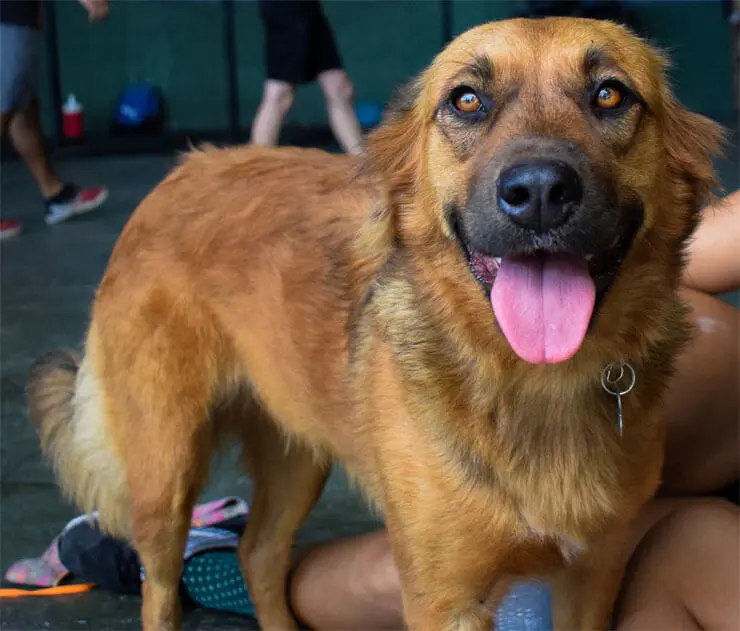
From Adobe Stock
As someone who’s spent years studying and appreciating the complexities of dog breeds, I find the story behind the German Shepherd Lab Mix particularly fascinating. It’s like piecing together a puzzle, where each piece represents the rich history and distinctive characteristics of two beloved breeds.
The German Shepherd: A Legacy of Strength and Intelligence
Originating from Germany in the late 19th century, the German Shepherd was bred for herding and guarding. Their exceptional intelligence and loyalty made them ideal for various roles beyond pastoral duties, including police and military work. German Shepherds have a storied reputation for their protective instincts and versatile skills, making them a universally respected breed.
The Labrador Retriever: A Symbol of Friendliness and Dedication
In contrast, the Labrador Retriever, hailing from the rugged coasts of Newfoundland, emerged as a fisherman’s aide, retrieving nets and lost fish. Their amiable nature and tireless work ethic quickly made them favored hunting companions and later, beloved family pets. Labs are renowned for their gentle demeanor and eagerness to please, qualities that have endeared them to millions globally.
The Birth of the German Shepherd Lab Mix
The creation of the German Shepherd Lab Mix, or German Sheprador, is a relatively recent chapter in canine history. This crossbreed likely emerged from a desire to meld the German Shepherd’s intelligence and protective nature with the Labrador’s affability and diligence. The result is a dog that embodies the finest traits of both breeds, adept at various roles, from service and therapy to being a cherished family companion.
The Rising Popularity of the Sheprador
The Sheprador’s journey to popularity is a testament to its remarkable qualities. As more people discover the balanced temperament and adaptability of this crossbreed, its appeal continues to grow. While not officially recognized by major kennel clubs due to its mixed heritage, the Sheprador has nonetheless carved out a place in the hearts of dog enthusiasts worldwide.
German Shepherd Lab Mix Physical Appearance
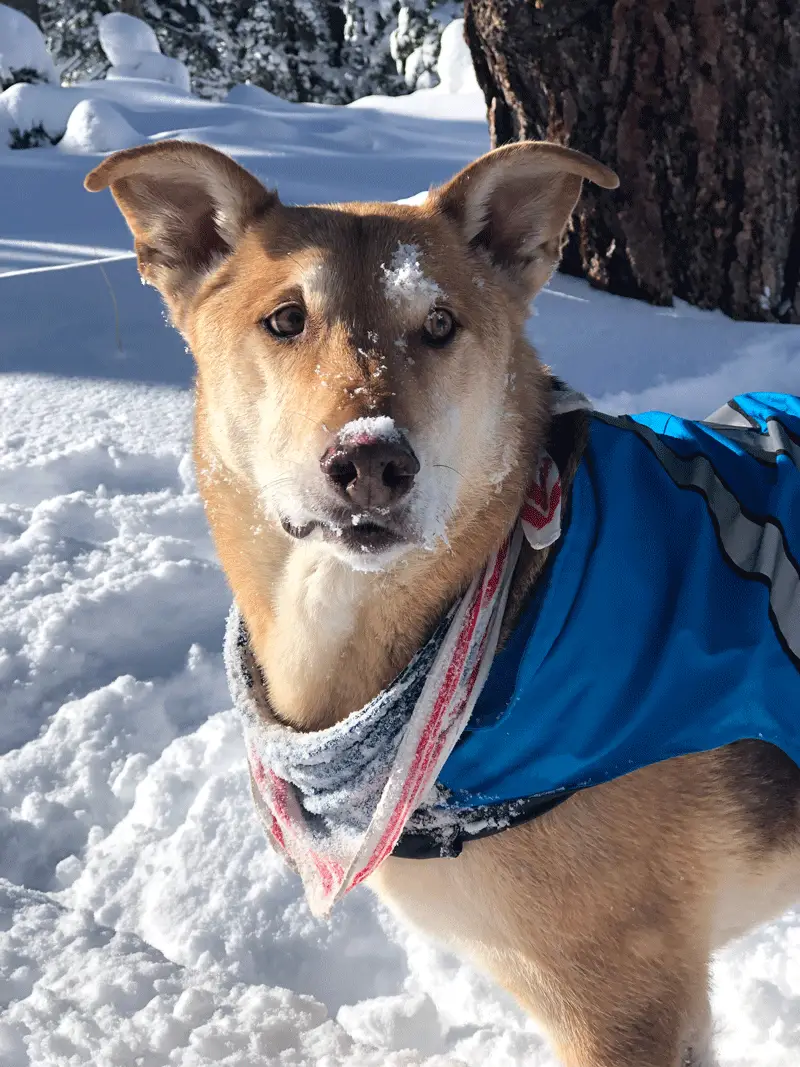
From Adobe Stock
The German Shepherd Lab Mix, a majestic culmination of two revered breeds, presents an appearance that is both awe-inspiring and warmly familiar. Each Sheprador is a unique blend, where the stately elegance of the German Shepherd meets the Labrador Retriever’s friendly demeanor. This combination results in a dog with a distinctive and captivating appearance, where no two Shepradors look exactly alike.
Size and Stature: A Robust Build
In terms of size and stature, the German Shepherd Lab Mix narrates a story of combined strength and agility. These dogs typically fall into the medium to large size category. They usually weigh between 50 to 80 pounds and stand approximately 20 to 27 inches tall at the shoulder.
This robust size is a testament to their German Shepherd and Labrador heritage. The mix features the muscular and commanding presence of the German Shepherd, alongside the solid and sturdy frame of the Labrador. This combination gives the Sheprador a versatile body, equally suitable for energetic activities and relaxed companionship.
Coat and Colors: A Diverse Palette
The coat of a Lab Shepherd Mix is where their diversity truly shines. It can range from the short and sleek style typical of a Labrador to a medium length that might remind you of a German Shepherd’s coat. This coat is usually dense and water-resistant, reflecting the utilitarian roots of both parent breeds.
In terms of color, the Sheprador’s palette is rich and varied. Their coats can display a range of colors including black, brown, tan, and yellow. Some may inherit the iconic black and tan markings of a German Shepherd, while others might showcase the solid hues characteristic of a Labrador.
Facial Features: Expressive and Endearing
The face of a German Shepherd Lab Mix is perhaps the most expressive aspect of their appearance. Their almond-shaped eyes are often deep and intelligent, reflecting a warm and inviting personality. The ears of the Sheprador can vary significantly, with some inheriting the erect ears of the German Shepherd and others displaying the floppy ears of the Labrador.
Meanwhile, the muzzle of the Lab German Shepherd Mix is usually of medium length, combining the distinct profiles of both parent breeds. This results in an alert and friendly expression that is both endearing and captivating. The combination of these facial features gives the Sheprador an undeniable charm, drawing from the best aspects of its parentage.
Personality and Temperament of the Lab Shepherd Mix
The German Shepherd Lab Mix embodies a personality and temperament that is as rich and varied as its physical appearance. This crossbreed brings together the best traits of its parent breeds, resulting in a companion that is both intelligent and affable.
Intelligence and Trainability
One of the most prominent traits of the Lab Shepherd Mix is its intelligence. Inherited from both the German Shepherd and the Labrador, this breed is quick to learn and eager to please. This high level of intelligence makes them highly trainable. They excel in obedience training and are often seen participating in agility and other canine sports. Their keen minds also mean they need mental stimulation to stay happy and engaged, so puzzle toys and regular training sessions are beneficial.
Loyalty and Protective Instincts
The Lab Shepherd Mix is known for its loyalty, a trait deeply ingrained from the German Shepherd side. This loyalty often translates into a protective instinct towards their family. They are naturally alert and can be cautious around strangers, making them excellent watchdogs. However, they are not overly aggressive, thanks to the balancing influence of the Labrador’s friendly nature.
Affectionate and Social Nature
The Labrador’s influence is evident in the Lab Shepherd Mix’s affectionate and social disposition. These dogs are known for their love of companionship, both with humans and other animals. They thrive in a family environment and are particularly good with children, displaying patience and gentleness. Their friendly demeanor makes them great candidates for multi-pet households as well.
Barking Tendencies
This mixed breed dog can be vocal, a trait they may inherit from the German Shepherd side. Their barking is usually purposeful, often used to alert their family to strangers or unusual occurrences. However, with proper training and socialization from a young age, they can learn to moderate their barking and understand when it is appropriate.
German shepherd lab mixes have the combined temperament of the watchful German shepherd and the easygoing Labrador retriever.
German Shepherd Lab Mix Care

From Adobe Stock
Caring for a German Shepherd Lab Mix is a journey filled with joy and responsibility. As a dog lover and an expert in animal behavior, I’ve learned that understanding and catering to the specific needs of this mixed breed is key to their well-being.
Exercise Needs
The boundless energy of the German Shepherd Lab Mix requires daily physical activity. These dogs don’t just love to play; they need it. Regular walks, jogs, or hikes are crucial to keep them physically fit and mentally sharp.
I’ve found that they particularly enjoy activities that challenge them both mentally and physically, such as fetch with a twist, like hiding the ball or alternating toys.
The German shepherd lab mix is an energetic breed that needs at least one hour of daily exercise, divided into two or more walks.
It’s not all about running and playing; these dogs thrive on challenges. Incorporating training exercises into their playtime, such as obstacle courses or hide-and-seek games, can provide the mental stimulation they crave.
Remember, a tired German Shepherd Lab Mix is a happy one, and this breed finds joy in activities that engage their intelligent minds.
Dietary Requirements
The German Shepherd Lab’s diet should be as dynamic as their personality. A balanced diet that’s high in quality protein is essential, but it’s also important to consider their individual needs, such as activity levels and health conditions. From personal observation, these dogs do well on a diet that includes a mix of dry kibble and wet food, ensuring they get a range of nutrients.
One thing to keep in mind, especially if your Sheprador leans more towards the Labrador side, is their love for food. This can lead to overeating and weight gain if not monitored. I recommend structured meal times and keeping treats to a minimum. Regular weigh-ins can help keep track of their weight, ensuring they stay within a healthy range.
On average, German shepherd lab mixes need about 3 cups of kibble per day.
Grooming Needs
Regular grooming is a must to maintain this dog’s coat. Brushing a few times a week not only keeps their coat shiny and healthy but also strengthens your bond with them. During shedding seasons, more frequent brushing is beneficial to manage the increased shedding.
Beyond brushing, their grooming routine should include regular nail trims, ear cleaning, and dental care. I’ve found that making grooming a positive experience from a young age helps immensely. Regular ear checks can prevent infections, especially in those with floppy ears, and good dental hygiene is essential for overall health.
Common Health Concerns in German Shepradors
These dogs can inherit several health concerns from their parent breeds. Being aware of these issues and understanding their implications is vital for any responsible owner.
Hip and Elbow Dysplasia
Hip and elbow dysplasia are developmental conditions where the hip or elbow joints don’t form correctly. This can lead to pain, lameness, and arthritis over time. Symptoms include difficulty in rising, reluctance to run or jump, and a noticeable limp. In severe cases, it can significantly impact the dog’s quality of life, leading to chronic pain and reduced mobility.
- Maintain regular, moderate exercise
- Keep your Sheprador at a healthy weight
- Use orthopedic dog beds for comfort
- Regular vet check-ups for early detection
- Consider supplements for joint health, as recommended by your vet
Bloat (Gastric Dilatation-Volvulus)
This health issue refers to a rapid onset and life-threatening condition where the dog’s stomach fills with gas and can twist. It prevents gas from escaping, cuts off blood flow, and can lead to tissue death. Symptoms include a swollen abdomen, excessive drooling, restlessness, and attempts to vomit without bringing anything up. Without immediate treatment, bloat can be fatal.
- Feed smaller, more frequent meals
- Avoid vigorous exercise after eating
- Consider using elevated food bowls
- Be vigilant for symptoms
- Have an emergency plan and know your nearest emergency vet’s location
Obesity
Like in humans, obesity in dogs can lead to a host of health problems, including diabetes, heart disease, and exacerbated joint issues. Symptoms include excessive body fat, lack of visible waistline, and decreased stamina. Obesity can significantly reduce a dog’s life expectancy and quality of life.
- Monitor and control portion sizes
- Provide a balanced, nutritious diet
- Ensure regular exercise
- Keep regular vet appointments for weight checks
- Limit treats and choose healthy snack options
Allergies
Allergies in dogs can be triggered by food, environmental factors, or flea bites. Symptoms vary but can include itchy skin, ear infections, constant licking, and gastrointestinal issues. Chronic allergies can lead to secondary infections and significantly impact a dog’s comfort and quality of life.
- Work with your vet to identify and avoid allergens
- Bathe your dog regularly with hypoallergenic shampoo
- Adjust diet to avoid food allergens
- Follow vet-recommended treatments for allergy relief
- Make necessary changes in your home to minimize exposure to allergens
How to Train a Labrashepherd
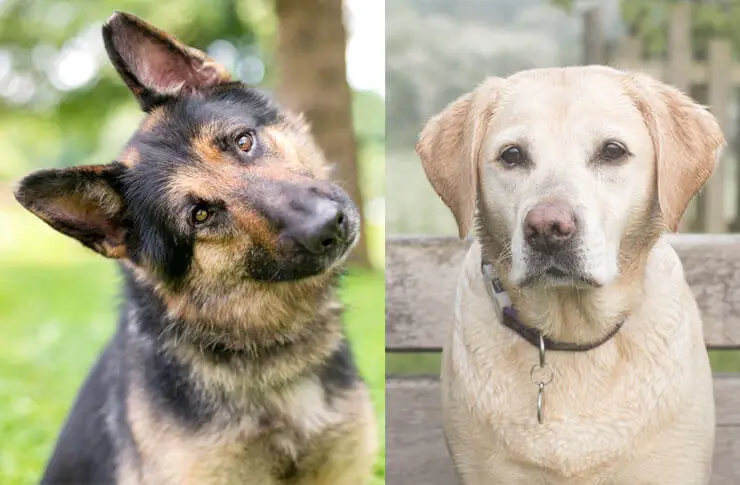
From Adobe Stock
Training a German Shepherd Labrador, known for their intelligence and eagerness to please, can be an enriching and enjoyable process. Drawing from my experience in animal behavior, I’ve found several effective strategies to train this mixed breed successfully.
Establishing Leadership
Building a relationship based on trust and respect is crucial in training. It’s important to establish yourself as a leader early on. This means setting rules, boundaries, and routines that your dog can understand and follow. Consistency in your commands and behavior is key to building this relationship.
Positive reinforcement is extremely effective with this breed. They respond well to praise, treats, and playtime as rewards for good behavior. This approach not only encourages them to repeat desired behaviors but also strengthens your bond with them.
Basic Obedience Training
Start with basic commands like ‘sit’, ‘stay’, ‘come’, and ‘heel’. These foundational commands are essential for their safety and socialization. German Shepherd Labradors are quick learners, so they often pick up these commands with ease.
Training sessions should be short, focused, and frequent. These dogs have a good attention span but benefit from short, consistent training sessions throughout the day. This keeps them engaged and prevents boredom.
Socialization
Expose your German Shepherd Labrador to different people, animals, environments, and situations from a young age. This exposure helps them become well-adjusted and confident adults.
Regular playdates with other dogs, visits to different environments like parks, and encountering various people will help in developing their social skills. Remember to always keep these interactions positive and controlled.
Advanced Training and Mental Stimulation
Given their high intelligence, German Shepherd Labradors thrive on mental stimulation. Once they master basic commands, you can move on to more advanced training. This includes tricks, agility training, and obedience competitions, which can be both mentally and physically stimulating for them.
Puzzle toys and games that challenge their intelligence are also great for mental stimulation. These can include hide-and-seek with toys or treats, puzzle feeders, and training new tricks.
Addressing Behavioral Issues
If you encounter behavioral issues, it’s important to address them early. Common issues like excessive barking, chewing, or jumping can be managed with consistent training. Understanding the root cause of these behaviors, like boredom or anxiety, is important in addressing them effectively.
Professional training classes or a dog behaviorist can be helpful, especially for more challenging issues or if you’re new to dog training.
Patience and Consistency
Patience and consistency are key in training a German Shepherd Labrador. They may learn at their own pace, and it’s important to be patient and consistent in your training approach. Celebrate their progress, no matter how small, and always end training sessions on a positive note.
The Cost of Owning a German Shepherd Lab Mix
Owning a German Shepherd Lab Mix involves a range of expenses, and potential owners need to have a realistic understanding of these costs. Here’s a breakdown of estimated expenses based on my experience and industry knowledge.
Initial Costs
- Purchase/Adoption Fees: Purchasing from a breeder can range from $700 to $2,000, while adoption fees typically range from $50 to $300, depending on the shelter or rescue organization.
- Initial Supplies: Setting up a new dog can cost around $200 to $500. This includes a crate, bedding, bowls, a collar, a leash, and initial toys.
Ongoing Food Expenses
- Dog Food: Monthly feeding costs can range from $40 to $80, depending on the brand and type of food. High-quality food tends to be at the higher end of this range.
- Treats and Supplements: Expect to spend about $10 to $30 per month on treats and any necessary supplements.
Veterinary Care
- Routine Check-ups and Vaccinations: Annual veterinary costs, including regular check-ups and vaccinations, can range from $200 to $500.
- Emergency and Health Issues: Setting aside $200 to $1,000 annually for unexpected health issues is advisable, considering potential hereditary conditions.
Grooming and Maintenance
- Grooming: Professional grooming costs can range from $30 to $90 per session, depending on the services. Home grooming supplies may add $50 to $100 annually.
- Exercise and Enrichment Toys: Budget around $50 to $100 per year for toys and exercise equipment.
Training Costs
- Obedience Classes: Group training classes can range from $50 to $150 for a series of sessions. Private dog training sessions can be more expensive.
Miscellaneous Expenses
- License: A dog license typically costs between $10 and $20 annually.
- Pet Insurance: Average pet insurance costs range from $200 to $600 per year, depending on the coverage.
- Travel and Boarding: Pet boarding services can cost $25 to $50 per night. Pet-friendly travel accommodations vary widely and should be budgeted for separately.
FAQs on the German Shepherd Lab Mix
Are German Shepherd Lab Mixes good family pets?
Yes, they generally make excellent family pets. They are known for their intelligence, loyalty, and friendly nature. They usually get along well with children and other pets, especially when socialized from a young age.
Do German Shepherd Lab Mixes shed a lot?
Yes, they can be moderate to heavy shedders, particularly during the shedding seasons. Regular grooming, including brushing a few times a week, is necessary to manage their shedding.
Is it easy to train a German Shepherd Lab Mix?
Yes, generally they are quite trainable. They are intelligent and eager to please, responding well to positive reinforcement techniques. Consistency and patience are key in their training.
What is the average lifespan of a German Shepherd Lab Mix?
The average lifespan is around 10 to 14 years, though this can vary depending on their health, diet, and exercise regimen.
Can German Shepherd Lab Mixes live in apartments?
While they can adapt to apartment living, they do best with access to a yard or frequent visits to a park for exercise. Their size and energy level mean they need ample space to move around.
So, Is a German Shepherd Lab Mix Right for You?
Deciding if a German Shepherd Lab Mix is the right dog for you involves understanding what kind of environment and lifestyle matches well with their characteristics and needs.
The German Sheprador Is For:
- Active Individuals or Families: If you lead an active lifestyle and enjoy spending time outdoors, a German Shepherd Lab Mix can be a great fit. Their energy and stamina make them excellent companions for hiking, running, and other outdoor activities.
- Experienced Dog Owners: Those who have experience in dog training and understand canine behavior may find this breed a good match. Their intelligence and trainability are rewarding for someone who knows how to channel these traits positively.
- Families with Children: With proper training and socialization, Lab Shepherds can be wonderful family pets. They are known for their loyalty and can be protective, gentle, and patient with children.
- Owners Looking for a Loyal Companion: If you’re seeking a loyal and affectionate pet, this breed could be a great choice. They often form strong bonds with their owners and are known for their protective nature.
- Homes with Adequate Space: German Shepradors will thrive in a home with ample space, preferably with a yard. They need room to move around and play.
The German Sheprador Isn’t For:
- First-Time Dog Owners: If you’re a first-time dog owner, a Lab Shepherd Mix might be challenging due to their size, energy levels, and training needs. They do best with owners who have experience in handling and training dogs.
- Busy or Absentee Owners: This breed may not be suitable for those with a very busy lifestyle or who are away from home frequently. German Shepradors require time, attention, and regular exercise, and they do not do well with neglect or prolonged isolation.
- Allergy Sufferers: If you have allergies to dog fur or dander, this might not be the breed for you, as they are moderate to heavy shedders, especially during shedding seasons.
- Apartment Dwellers: While adaptable, German Shepradors are best suited to homes with more space. They can live in apartments, but it’s more challenging to meet their exercise and space needs in smaller living environments.
- Owners Unwilling to Commit Time for Training and Exercise: Commitment to regular training and daily exercise is crucial for this breed. If you’re not able to commit the necessary time for their physical and mental well-being, this breed may not be the best fit.
More German Shepherd and Labrador Retriever Mixes
Want a German shepherd mix or Labrador retriever mix but aren’t keen on the German shepherd labrador mix? Check out these other hybrid dog breeds:
German Shepherd Mixes
- German Shepherd Husky Mix
- Australian Shepherd German Shepherd Mix
- German Shepherd Poodle Mix
- Golden Shepherd
- German Shepherd Wolf Mix
- German Shepherd Rottweiler Mix
- Border Collie German Shepherd Mix
- German Shepherd Boxer Mix
- Great Pyrenees German Shepherd Mix
- German Shepherd Beagle Mix
- German Shepherd Golden Retriever Mix
- Corgi German Shepherd Mix
- German Shepherd Pitbull Mix


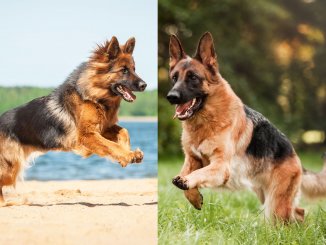
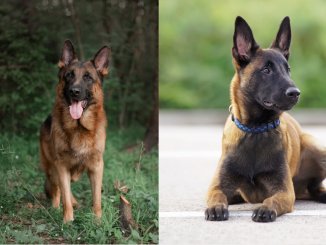
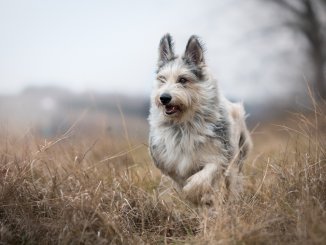

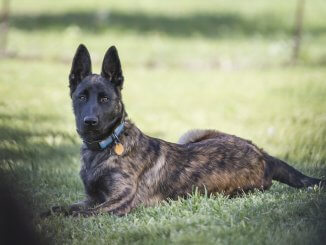
Thanks for all the information on the Shepard lab mix. I had this mix when I was a Young man and Was telling my wife a few days ago that was probably the best dog I’ve had.
Good to know Scott. I too grew up with a german shepherd & black labs.
(seperate breeds not mixed)
The shepherd was my best friend.